Artículos SCI
2020
2020
Materiales Nanoestructurados y Microestructura
Low gas consumption fabrication of He-3 solid targets for nuclear reactions
Fernandez, A; Hufschmidt, D; Colaux, JL; Valiente-Dobon, JJ; Godinho, V; de Haro, MCJ; Feria, D; Gadea, A; Lucas, SMaterials & Design, 186 (2020) 108337
Show abstract ▽
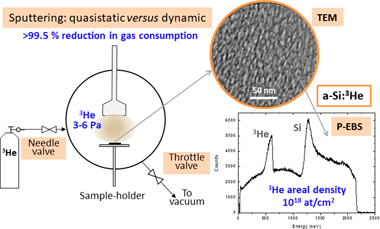
Nanoporous solids that stabilize trapped gas nanobubbles open new possibilities to fabricate solid targets for nuclear reactions. A methodology is described based on the magnetron sputtering (MS) technique operated under quasistatic flux conditions to produce such nanocomposites films with He-3 contents of up to 16 at.% in an amorphous-silicon matrix. In addition to the characteristic low pressure (3-6 Pa) needed for the gas discharge, the method ensures almost complete reduction of the process gas flow during film fabrication. The method could produce similar materials to those obtained under classical dynamic flux conditions for MS. The drastic reduction (>99.5%) of the gas consumption is fundamental for the fabrication of targets with scarce and expensive gases. Si:He-3 and W:He-3 targets are presented together with their microstructural (scanning and transmission electron microscopy, SEM and TEM respectively) and compositional (Ion Beam Analysis, IBA) characterization. The He-3 content achieved was over 1 x 10(18) at/cm(2) for film thicknesses between 1.5 and 3 mu m for both Si and W matrices. First experiments to probe the stability of the targets for nuclear reaction studies in inverse kinematics configurations are presented.
Enero, 2020 | DOI: 10.1016/j.matdes.2019.108337
2019
2019
Nanotecnología en Superficies y Plasma
3D Organic Nanofabrics: Plasma-Assisted Synthesis and Antifreezing Behavior of Superhydrophobic and Lubricant-Infused Slippery Surfaces
Alcaire, M; Lopez-Santos, C; Aparicio, FJ; Sanchez-Valencia, JR; Obrero, JM; Saghi, Z; Rico, VJ; de la Fuente, G; Gonzalez-Elipe, AR; Barranco, A; Borras, ALangmuir, 35 (2019) 16876-16885
Show abstract ▽
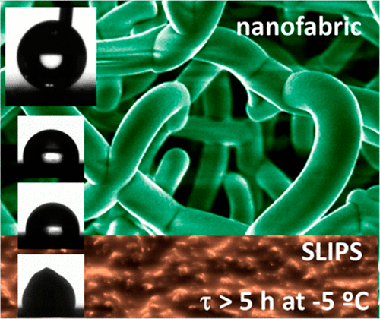
Herein, we present the development of supported organic nanofabrics formed by a conformal polymer-like interconnection of small-molecule organic nanowires and nanotrees. These organic nanostructures are fabricated by a combination of vacuum and plasma-assisted deposition techniques to generate step by step, single-crystalline organic nanowires forming one-dimensional building blocks, organic nanotrees applied as three-dimensional templates, and the polymer-like shell that produces the final fabric. The complete procedure is carried out at low temperatures and is compatible with an ample variety of substrates (polymers, metal, ceramics; either planar or in the form of meshes) yielding flexible and low solid-fraction three-dimensional nanostructures. The systematic investigation of this progressively complex organic nanomaterial delivers key clues relating their wetting, nonwetting, and anti-icing properties with their specific morphology and outer surface composition. Water contact angles higher than 150° are attainable as a function of the nanofabric shell thickness with outstanding freezing-delay times (FDT) longer than 2 h at −5 °C. The role of the extremely low roughness of the shell surface is settled as a critical feature for such an achievement. In addition, the characteristic interconnected microstructure of the nanofabrics is demonstrated as ideal for the fabrication of slippery liquid-infused porous surfaces (SLIPS). We present the straightforward deposition of the nanofabric on laser patterns and the knowledge of how this approach provides SLIPS with FDTs longer than 5 h at −5 °C and 1 h at −15 °C.
Diciembre, 2019 | DOI: 10.1021/acs.langmuir.9b03116
Materiales de Diseño para la Energía y Medioambiente
Design swelling micas: Insights on heavy metals cation exchange reaction
Osuna, FJ; Pavon, E; Alba, MDApplied Clay Science, 182 (2019) 105298
Show abstract ▽
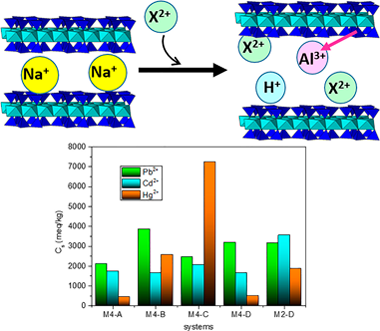
Heavy metal pollution has become one of the most serious environmental problems, demanding specialized remediation mechanisms. Among the studied treatments, ion-exchange processes have been widely used due to their high remediation capacity, efficiency and fast kinetic. Here, the potential use of a new family of design micas as cation exchanger has been analysed. Micas with a layer charge in the range of brittle micas have been synthesized and their heavy metals cation exchange capacity analysed as a function of the nature of the heavy metal cations (Pb2+, Cd2+ or Hg2+), the nature of the counterions (Cl− or NO3−), concentration of the solutions and the micas layer charge. A cation exchange ratio between 35% and 154% of their cation exchange capacity (CEC) was achieved, being more efficient when mica layer charge diminished. In general, the maximum adsorption capacity followed the trend: Hg2+ > Pb2+ > Cd2+. The efficiency of the cation exchange and adsorption mechanism of the synthetic micas depended on the experimental conditions and they were more efficient than raw and modified natural clay minerals.
Diciembre, 2019 | DOI: 10.1016/j.clay.2019.105298
Materiales de Diseño para la Energía y Medioambiente
Understanding segregation processes in SAMs formed by mixtures of hydroxylated and non-hydroxylated fatty acids
Bueno, OVM; Benitez, JJ; San-Miguel, MARSC Advances, 9 (2019) 39252-39263
Show abstract ▽
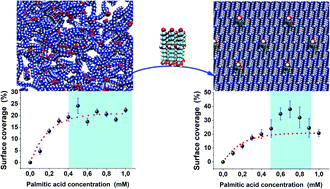
In this paper, we focus on the segregation processes emerging when preparing mixtures with different compositions of aleuritic (9,10,16 trihydroxyhexadecanoic) (ALE) and palmitic (hexadecanoic) (PAL) acids. The combination of atomic force microscopy (AFM) and molecular dynamics (MD) simulations enabled us to prove the role of the functional groups in the formation of self-assembled monolayers (SAMs) on muscovite mica surfaces. MD simulations indicate that segregation processes are favored in high ALE composition mixtures in agreement with the experimental evidence, whereas low ALE compositions promote the co-existence between segregated and dispersed systems. The secondary hydroxyl groups play a central role in the self-assembling mechanism because they control the formation of hydrogen bonding networks guarantying system stability.
Diciembre, 2019 | DOI: 10.1039/c9ra06799j
Reactividad de Sólidos
Low temperature synthesis of an equiatomic (TiZrHfVNb)C5 high entropy carbide by a mechanically-induced carbon diffusion route
Chicardi, E; Garcia-Garrido, C; Gotor, FJCeramics International, 45 (2019) 21858-21863
Show abstract ▽
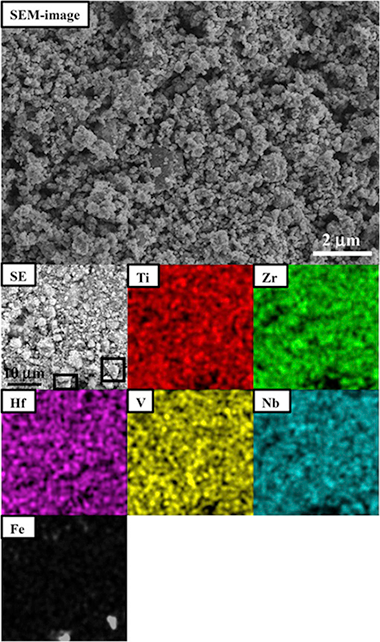
A novel, homogeneous, nanostructured and equiatomic (TiZrHfVNb)C-5 High Entropy Carbide (HEC) was successfully synthesised in a powder form by a mechanosynthesis process from the elemental mixture. This synthesis method for HECs, not previously reported, is simple, reproducible and carried out at room temperature. During milling, the transition metals (Ti, Zr, Hf, V and Nb) alloying and the diffusion of carbon (introduced as graphite) into the alloy structure are simultaneously induced, obtaining the expected (TiZrHfVNb)C-5 HEC. The room temperature method employed contrasts with those reported in the bibliography from binary carbides that are carried out at a very high temperature (1800-2200 degrees C), with the consequent energy savings.
Diciembre, 2019 | DOI: 10.1016/j.ceramint.2019.07.195
- ‹ anterior
- 110 of 410
- siguiente ›














